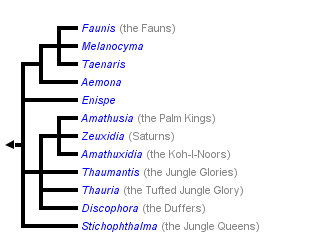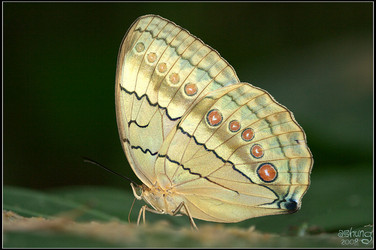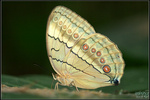Amathusiini
Niklas Wahlberg and Andrew V. Z. Brower


This tree diagram shows the relationships between several groups of organisms.
The root of the current tree connects the organisms featured in this tree to their containing group and the rest of the Tree of Life. The basal branching point in the tree represents the ancestor of the other groups in the tree. This ancestor diversified over time into several descendent subgroups, which are represented as internal nodes and terminal taxa to the right.

You can click on the root to travel down the Tree of Life all the way to the root of all Life, and you can click on the names of descendent subgroups to travel up the Tree of Life all the way to individual species.
For more information on ToL tree formatting, please see Interpreting the Tree or Classification. To learn more about phylogenetic trees, please visit our Phylogenetic Biology pages.
close boxIntroduction
An Indo-Australasian clade of large forest floor-dwelling butterflies. Amathusiini were formerly considered a tribe of "Morphinae," but they are no more closely-related to the neotropical morphines than either is to various other groups of Satyrinae.Discussion of Phylogenetic Relationships
Corbet et al. (1992) state that Faunis, Melanocyma and Taenaris "form a natural group probably worthy of subtribal rank ... ." This hypothesis is supported by preliminary molecular results (Peña et al. 2006, Wahlberg & Brower unpubl.). Hyantis and Morphopsis, two New Guinean genera traditionally included in Amathusiini, appear to be associated instead with Elymniiini. Note that Xanthataenia is not an amathusiine. This was pointed out by Corbet et al. (1992) on the basis of larval morphology, and has been corroborated by molecular evidence (Wahlberg & Brower, unpubl.).
References
Corbet AS, Pendlebury HM, and Eliot JN. 1992. The butterflies of the Malay Peninsula. Malayan Nature Society, Kuala Lumpur.
Parsons M. 1999. The butterflies of Papua New Guinea: their systematics and biology. Academic Press, San Diego.
Pena C, Wahlberg N, Weingartner E, Kodandaramaiah U, Nylin S, Freitas AVL, and Brower AVZ. 2006. Higher level phylogeny of Satyrinae butterflies (Lepidoptera: Nymphalidae) based on DNA sequence data. Mol. Phylogenet. Evol. 40: 29-49.
Title Illustrations

| Scientific Name | Faunis eumeus |
|---|---|
| Location | So Uk, Kowloon, Hong Kong |
| Specimen Condition | Live Specimen |
| Source | Mr. Blue Eyes |
| Source Collection | Flickr |
| Image Use |
 This media file is licensed under the Creative Commons Attribution-ShareAlike License - Version 2.0. This media file is licensed under the Creative Commons Attribution-ShareAlike License - Version 2.0.
|
| Copyright | © 2007 Charles Lam |
| Scientific Name | Stichophthalma howqua |
|---|---|
| Location | Taiwan |
| Specimen Condition | Live Specimen |
| Source | 箭環蝶(環紋蝶)Stichophthalma howqua formosana Fruhstorfer |
| Source Collection | Flickr |
| Image Use |
 This media file is licensed under the Creative Commons Attribution-NonCommercial-ShareAlike License - Version 2.0. This media file is licensed under the Creative Commons Attribution-NonCommercial-ShareAlike License - Version 2.0.
|
| Copyright | © 2008 ashung |
About This Page
Niklas Wahlberg

University of Turku, Finland

Middle Tennessee State University, Murfreesboro, Tennessee, USA
Correspondence regarding this page should be directed to Niklas Wahlberg at and Andrew V. Z. Brower at
Page copyright © 2009 Niklas Wahlberg and
 Page: Tree of Life
Amathusiini .
Authored by
Niklas Wahlberg and Andrew V. Z. Brower.
The TEXT of this page is licensed under the
Creative Commons Attribution License - Version 3.0. Note that images and other media
featured on this page are each governed by their own license, and they may or may not be available
for reuse. Click on an image or a media link to access the media data window, which provides the
relevant licensing information. For the general terms and conditions of ToL material reuse and
redistribution, please see the Tree of Life Copyright
Policies.
Page: Tree of Life
Amathusiini .
Authored by
Niklas Wahlberg and Andrew V. Z. Brower.
The TEXT of this page is licensed under the
Creative Commons Attribution License - Version 3.0. Note that images and other media
featured on this page are each governed by their own license, and they may or may not be available
for reuse. Click on an image or a media link to access the media data window, which provides the
relevant licensing information. For the general terms and conditions of ToL material reuse and
redistribution, please see the Tree of Life Copyright
Policies.
- First online 25 September 2006
- Content changed 16 November 2009
Citing this page:
Wahlberg, Niklas and Andrew V. Z. Brower. 2009. Amathusiini . Version 16 November 2009 (under construction). http://tolweb.org/Amathusiini/70273/2009.11.16 in The Tree of Life Web Project, http://tolweb.org/









 Go to quick links
Go to quick search
Go to navigation for this section of the ToL site
Go to detailed links for the ToL site
Go to quick links
Go to quick search
Go to navigation for this section of the ToL site
Go to detailed links for the ToL site